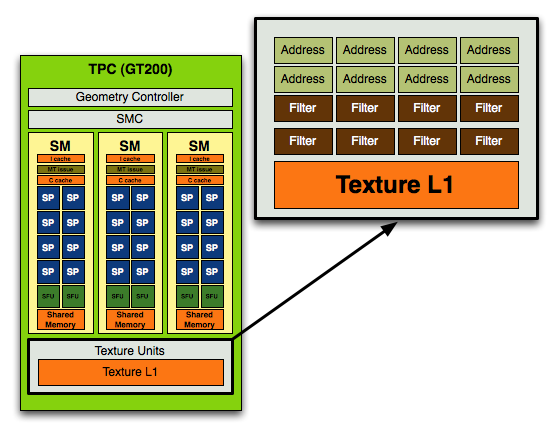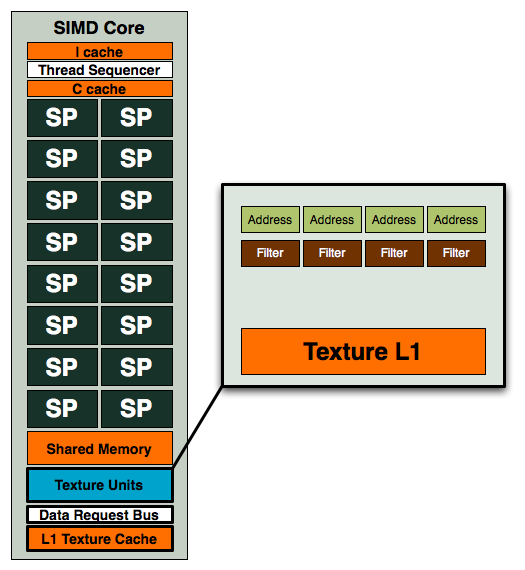The Radeon HD 4850 & 4870: AMD Wins at $199 and $299
by Anand Lal Shimpi & Derek Wilson on June 25, 2008 12:00 AM EST- Posted in
- GPUs
That Darn Compute:Texture Ratio
With its GT200 GPU, NVIDIA increased compute resources by nearly 90% but only increased texture processing by 25%, highlighting a continued trend in making GPUs even more powerful computationally. Here's another glance at the GT200's texture address and filter units:

Each TPC, of which there are 10, has eight address and eight filter units. Now let's look at RV770:

Four address and four filter units, while AMD maintains the same 1:1 address-to-filter ratio that NVIDIA does, the ratio of compute-to-texture in RV770 is significantly higher.
| AMD RV770 | AMD RV670 | NVIDIA GT200 | NVIDIA G92 | |
| # of SPs | 160 | 64 | 240 | 128 |
| Texture Address/Filter Units | 40 / 40 | 16 / 16 | 80 / 80 | 64 / 64 |
| Compute to Texture Ratio | 4:1 | 4:1 | 3:1 | 2:1 |
The table above illustrates NVIDIA's trend of increasing the compute to texture ratio from 2:1 in G92 to 3:1 in GT200. AMD arguably overshot with RV670 and its 4:1 ratio and thus didn't need to adjust it with RV770. Even while staying still at 4:1 with RV770, AMD's ratio is still more aggressively geared towards compute than NVIDIA's is. That does mean that more texture bound games will do better on NVIDIA hardware (at least proportionally), while more compute intensive games may do better on RV770.
AMD did also make some enhancements to their texture units as well. By doing some "stuff" that they won't tell us about, they improved the performance per mm^2 by 70%. Texture cache bandwidth has also been doubled to 480 GB/s while bandwidth between each L1 cache and L2 memory is 384 GB/s. L2 caches are aligned with memory channels of which there are four interleaved channels (resulting in 8 L2 caches).
Now that texture units are linked to both specific SIMD cores and individual L1 texture caches, we have an increase in total texturing ability due to the increase in SIMD cores with RV770. This gives us a 2.5x increase in the number of 8-bit per component textures we can fetch and bilinearly filter per clock, but only a 1.25x increase in the number of fp16 textures (as fp16 runs at half rate and fp32 runs at one quarter rate). It was our understanding that fp16 textures could run at full speed on R600, so the 1.25x increase in performance for half rate texturing of fp16 data makes sense.
Even though fp32 runs at quarter rate, with the types of texture fetches we would need to do, AMD says that we could end up being external memory bandwidth bound before we are texture filtering hardware bound. If this is the case, then the design decision to decrease rates for higher bit-depth textures makes sense.
| AMD RV770 | AMD RV670 | |
| L1 Texture Cache | 10 x 16KB (160KB total) | 32KB |
| L2 Texture Cache | I can has cache size? | 256KB |
| Vertex Cache | ? | 32KB |
| Local Data Share | 16KB | None |
| Global Data Share | 16KB | ? |
Even though AMD wouldn't tell us L1 cache sizes, we had enough info left over from the R600 time frame to combine with some hints and extract the data. We have determined that RV770 has 10 distinct 16k caches. This is as opposed to the single shared 32k L1 cache on R600 and gives us a total of 160k of L1 cache. We know R600's L2 cache was 256k, and AMD told us RV770 has a larger L2 cache, but they wouldn't give us any hints to help out.










215 Comments
View All Comments
araczynski - Wednesday, June 25, 2008 - link
...as more and more people are hooking up their graphics cards to big HDTVs instead of wasting time with little monitors, i keep hoping to find out whether the 9800gx2/4800 lines have proper 1080p scaling/synching with the tvs? for example the 8800 line from nvidia seems to butcher 1080p with tv's.anyone care to speak from experience?
DerekWilson - Wednesday, June 25, 2008 - link
i havent had any problem with any modern graphics card (dvi or hdmi) and digital hdtvsi haven't really played with analog for a long time and i'm not sure how either amd or nvidia handle analog issues like overscan and timing.
araczynski - Wednesday, June 25, 2008 - link
interesting, what cards have you worked with? i have the 8800gts512 right now and have the same problem as with the 7900gtx previously. when i select 1080p for the resolution (which the drivers recognize the tv being capable of as it lists it as the native resolution) i get a washed out messy result where the contrast/brightness is completely maxed (sliders do little to help) as well as the whole overscan thing that forces me to shrink the displayed image down to fit the actual tv (with the nvidia driver utility). 1600x900 can usually be tolerable in XP (not in vista for some reason) and 1080p is just downright painful.i suppose it could by my dvi to hdmi cable? its a short run, but who knows... i just remember reading a bit on the nvidia forums that this is a known issue with the 8800 line, so was curious as to how the 9800 line or even the 4800 line handle it.
but as the previous guy mentioned, ATI does tend to do the TV stuff much better than nvidia ever did... maybe 4850 crossfire will be in my rig soon... unless i hear more about the 4870x2 soon...
ChronoReverse - Wednesday, June 25, 2008 - link
ATI cards tend to do the TV stuff properlyFXi - Wednesday, June 25, 2008 - link
If Nvidia doesn't release SLI to Intel chipsets (and on a $/perf ratio it might not even help if it does), the 4870 in CF is going to stop sales of the 260's into the ground.Releasing SLI on Intel and easing the price might help ease that problem, but of course they won't do it. Looks like ATI hasn't just come back, they've got a very, very good chip on their hands.
Powervano - Wednesday, June 25, 2008 - link
Anand and DerekWhat about temperatures of HD4870 under IDLE and LOAD? page 21 only shows power comsumption.
iwodo - Wednesday, June 25, 2008 - link
Given how ATI architecture greatly rely on maximizing its Shader use, wouldn't driver optimization be much more important then Nvidia in this regard?And is ATI going about Nvidia CUDA? Given CUDA now have a much bigger exposure then how ever ATI is offering.. CAL or CTM.. i dont even know now.
DerekWilson - Wednesday, June 25, 2008 - link
getting exposure for AMD's own GPGPU solutions and tools is going to be though, especially in light of Tesla and the momentum NVIDIA is building in the higher performance areas.they've just got to keep at it.
but i think their best hope is in Apple right now with OpenCL (as has been mentioned above) ...
certainly AMD need to keep pushing their GPU compute solutions, and trying to get people to build real apps that they can point to (like folding) and say "hey look we do this well too" ...
but in the long term i think NVIDIA's got the better marketing there (both to consumers and developers) and it's not likely going to be until a single compute language emerges as the dominant one that we see level competition.
Amiga500 - Wednesday, June 25, 2008 - link
AMD are going to continue to use the open source alternative - Open CL.In a relatively fledgling program environment, it makes all the sense in the world for developers to use the open source option, as compatibility and interoperability can be assured, unlike older environments like graphics APIs.
OSX v10.6 (snow lepoard) will use Open CL.
DerekWilson - Wednesday, June 25, 2008 - link
OpenCL isn't "open source" ...Apple is trying to create an industry standard heterogeneous compute language.
What we need is a compute language that isn't "owned" by a specific hardware maker. The problem is that NVIDIA has the power to redefine the CUDA language as it moves forward to better fit their architecture. Whether they would do this or not is irrelevant in light of the fact that it makes no sense for a competitor to adopt the solution if the possibility exists.
If NVIDIA wants to advance the industry, eventually they'll try and get CUDA ANSI / ISO certified or try to form an industry working group to refine and standardize it. While they have the exposure and power in CUDA and Tesla they won't really be interested in doing this (at least that's our prediction).
Apple is starting from a standards centric view and I hope they will help build a heterogeneous computing language that combines the high points of all the different solutions out there now into something that's easy to develop or and that can generate code to run well on all architectures.
but we'll have to wait and see.